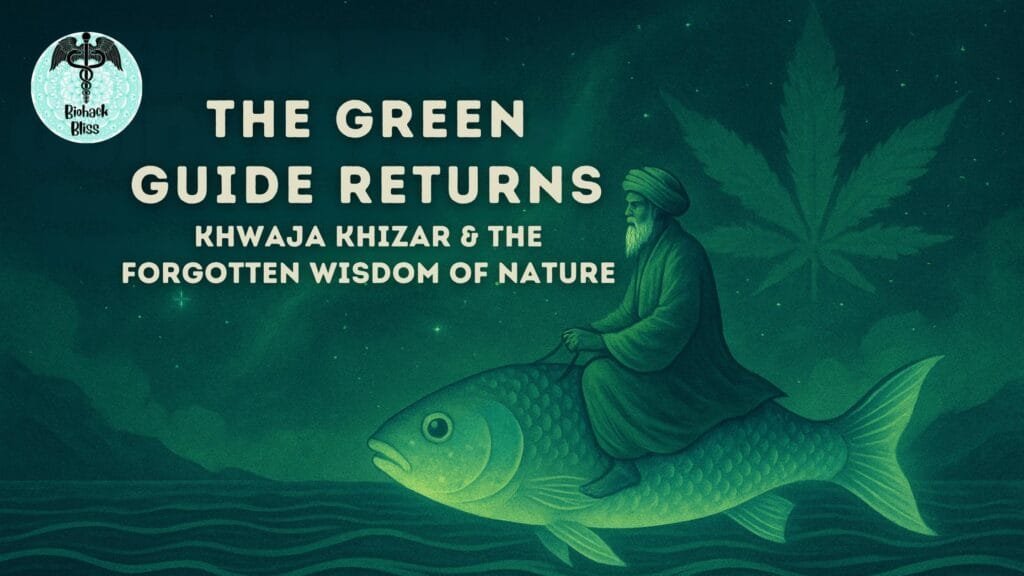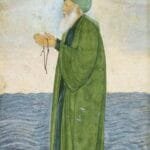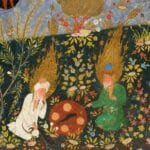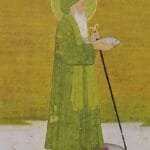Who Is Khwaja Khizar?
Khwaja Khizar — also known as Al-Khidr — is one of the most enduring mystical figures in Islamic and South Asian tradition. His name comes from the Arabic root kh-d-r, meaning “green.” The Qur’an (Surah Al-Kahf, 18:60–82) describes him as a servant of God, endowed with divine knowledge (ʿilm ladunnī), who imparts lessons to Prophet Musa (Moses) that transcend human logic.
In Sufi traditions across Punjab and Sindh, Khizar is revered as the unseen guide of travelers, seekers, and mystics. He is believed to appear by rivers or gardens, symbolizing renewal, protection, and hidden wisdom.
The Green Symbolism: Water, Fish & Life
Khizar is almost always depicted in South Asian art riding a great fish, cloaked in green, moving across the waters of life.
The fish symbolizes navigation through chaos, spiritual rebirth, and the passage between seen and unseen worlds. Folklore in Sindh often identifies this fish with the palla of the Indus River, known for its strength in swimming upstream.
This symbolism is why Khizar is remembered not just as a saint of water, but as a saint of renewal — a reminder that balance lies in living close to nature.
Green Wisdom & Herbal Symbolism in Sufi Traditions
Although the Qur’an does not link Khizar to any specific plant, South Asian Sufi traditions have long associated him with green herbs used in contemplation. Among these, cannabis/hemp (bhang, hashish, charas) became a symbolic part of his domain — not as escape, but as a plant teacher.
- In Qalandari and Malamati orders, bhang was used to quiet the ego and prepare the heart for silence.
- Folklore often calls Khizar the “patron saint of cannabis,” with the green leaf seen as an emblem of inner vision and timeless vitality.
- Poets described the herb as “Khizar’s cup” — a bridge between human restlessness and divine stillness.
For Sufis, the plant was not about intoxication, but initiation — another way Khizar guided seekers when no human teacher was present.
Ibn al-ʿArabi & The Eternal Teacher
The great Andalusian mystic Ibn al-ʿArabi (1165–1240) described Khizar as the eternal initiator of seekers who walk the path alone. It is per
Their meeting in Seville was, according to Ibn al-ʿArabi, a wordless initiation — a transmission of divine presence.
It is pertinent to note that Ibn al-ʿArabi introduced the profound doctrine of Wahdat-ul-Wujūd — the Unity of Being. This teaching emphasizes that all existence is a manifestation of the One Divine Essence, and that separation is only an illusion of perception. His vision of oneness closely resonates with other global traditions of non-duality: the Advaita Vedanta concept of Brahman in Hindu philosophy, the Taoist principle of harmony between yin and yang, and even shamanic understandings of dissolution and rebirth where the self is reintegrated into the larger whole. In each case, the message is similar — that true awakening lies in realizing the interconnectedness of all life and seeing the Divine reflected in every form.
For Ibn al-ʿArabi, Khizar embodies this principle of oneness — the “green current” flowing through creation, guiding seekers to experience unity with the Divine through stillness, nature, and hidden wisdom. This mirrors shamanic and Taoist traditions, where crisis, solitude, or encounters with nature can trigger transformation and awakening. The great Sufi mystic Ibn al-ʿArabi went on to further describe Khizar as the eternal initiator of the “solitary ones” — seekers without teachers. Their meeting in Seville was a silent initiation: no words, no rituals, only presence.
This mirrors shamanic and Eastern sufi traditions where crisis, solitude, and even plant journeys become pathways to awakening. For Ibn al-ʿArabi, Khizar was not myth, but the ever-present green current running through creation.
Khizar in Literature & Culture
- Iqbal’s Khizr-e-Rah: Allama Iqbal devoted an entire poem to Khizar, presenting him as the voice of courage and higher consciousness during times of civilizational crisis. His metaphor of barg-e-hasheesh (the leaf of hashish) was not a glorification, but a reminder that true vitality comes from uniting thought and action, not seeking numbness.
- Diriliş: Ertuğrul: The popular series shows Ibn al-ʿArabi evoking Khizar and the Fountain of Youth — symbols of hidden wisdom and spiritual continuity.
- Oral Tradition: Fakirs by the Indus still tell stories of Khizar’s cup, green herbs, and riverside teachings, echoing Idries Shah’s observation that Khizar appears most often to seekers without guides.
Lessons from Musa & Khizr
The Qur’an’s story of Musa and Khidr reminds us that hidden wisdom often appears paradoxical. Damaging a boat saved fishermen from tyranny; ending a life spared parents from grief; rebuilding a wall preserved treasure for orphans.
The takeaway: what looks harmful may be protection; what looks meaningless may hold divine purpose. The same paradox appears in Sufi reflections on the green leaf — it can numb or awaken, depending on intention.
The Green Path in Modern Times
Today, Khizar’s symbolism still speaks:
- Plants as Guides — Nature offers tools for healing and insight.
- Trusting the Unseen — True guidance is not always logical, but it is transformative.
- Balance in Green — Renewal comes from harmonizing with life’s natural rhythms.
Walking with Khizar
The legacy of Khwaja Khizar is not about relics or legends alone — it is about rediscovering balance in a world that often feels chaotic. His cloak of green and his association with rivers, fish, and even cannabis remind us that nature is a guide, not an escape.
At Biohack Bliss, we honor this same wisdom — uniting Sufi tradition, natural wellness, and modern science in our botanical blends.
Note:
This article is a condensed version of the original blog published on CBD Oil Pakistan’s website:
https://cbdvape-pakistan.com/blog/khwaja-khizar-cannabis-sufism/Biohack Bliss is a project of Shamanic Biohacker LLC., uniting ancient wisdom with modern wellness.
References (APA Format)
Booth, M. (2003). Cannabis: A History. New York: Picador. Retrieved from https://archive.org/details/cannabishistory0000boot
Coomaraswamy, A. K. (1943). Figures of Speech or Figures of Thought? Cambridge, MA: Harvard University Press. Retrieved from https://archive.org/details/figuresofspeecho0000coom
Ernst, C. W. (1997). The Shambhala Guide to Sufism. Boston: Shambhala Publications. Retrieved from https://archive.org/details/shambhalaguideto00erns
Iqbal, M. (1927). Khizr-e-Rah. In Bang-e-Dra. Lahore: Sheikh Ghulam Ali & Sons. Retrieved from https://www.iqbal.com.pk/bang/poem.asp?id=354
Quran.com. (n.d.). Surah Al-Kahf (18:60–82). Retrieved from https://quran.com/18/60-82
Shah, I. (1991). The Way of the Sufi. London: Octagon Press. Retrieved from https://archive.org/details/wayofsufi00idri
Yaqoob, A. (2014). Folklore and Faith: Khwaja Khizar in Sindhi Oral Tradition. Lahore: Folklore Studies Review. (No online version available — reference for print journal).
Wikimedia Commons. (n.d.). Category: Khidr. Retrieved August 19, 2025, from https://commons.wikimedia.org/wiki/Category:Khidr
Bibliothèque nationale de France. (ca. 1760). The Prophet Khizr Khan Khwaja [Miniature painting]. Wikimedia Commons. Retrieved August 19, 2025, from https://commons.wikimedia.org/wiki/File:42_The_prophet_Khizr_Khan_Khwaja_ca._1760_Biblioth%C3%A8que_nationale_de_France,_Paris.jpg
Wikipedia contributors. (2025, August 19). Fountain of Youth. In Wikipedia. Retrieved from https://en.wikipedia.org/wiki/Fountain_of_Youth
V&A Images. (n.d.). Khwaja Khizr standing on a fish, Punjab Plain, late [Photograph]. Retrieved August 19, 2025, from https://www.vandaimages.com/2013GM5141-Khwaja-Khizr-standing-on-a-fish-Punjab-Plain-late.html
- All
- Blog
- CBD OIL PAKISTAN

🌿 Khwaja Khizar & The Mystical Legacy of Green Wellness

Where to Buy Lab-Tested CBD Oil in Pakistan: A Comprehensive Guide

Gut-Brain Mood Connection: How Your Second Brain Impacts Emotion and Balance

Natural Solution for Burnout and Stress: How Busy Professionals Are Finding Relief

Unlocking Pain Relief: The Power of Anxiety & Stress Relief Botanical Blend from Biohack Bliss

Holistic Approaches to Anxiety: Botanical Solutions

The Holistic Approach to Long-Term Stress Management
In our fast-paced world, stress has become an unwelcome companion for many of us. The demands of daily life, work pressures, and personal challenges often





